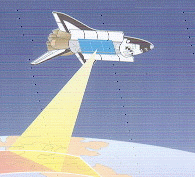 |
 |
 NASA SIR-C/X-SAR Mission
NASA SIR-C/X-SAR Mission
 SIR-C/X-SAR is a joint project of the National Aeronautics and Space Administration (NASA), the German Space Agency (DARA) and the Italian Space Agency (ASI). It was flown aboard the space shuttle from 9 to 20 April 1994 and 30 Spetember to 11 October 1994. The multifrequency, multipolarization Synthetic Aperture Radar (SAR) system allows measurement of radar backscattering signature of the Earth's surface from space, at three different frequencies (L, C and X-bands) and at different polarizations. The SIR-C instrument is a two-frequency radar including L-band (23 cm wavelength) and C-band (6 cm wavelength) with four polarizations (HH, HV, VH, VV). The X-SAR instrument is a single-frequency radar with X-band (3 cm wavelength) and vertical polarization (VV).
BFPQ = Block Floating Point Quantization, a form of data compression from 8bits per sample to 4 bits per sample. System Parameters
Link to: SIR-C Home Page (http://southport.jpl.nasa.gov/sir-c/) at JPL, NASA  Back to Main Index Back to Main Index
|